Hydrangea paniculata: description, varieties, planting, care and reproduction
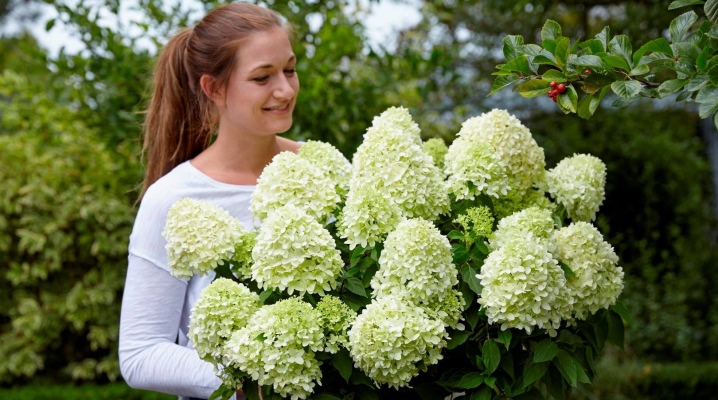
Panicle hydrangea is a plant that adorns gardens and plots around the world. She is loved for its lush and long flowering. From summer to late autumn, it creates a gentle and romantic atmosphere on the territory of a house or other building. In the domestic landscape design, this plant has become one of the most popular, because it belongs to perennial shrubs, modest and unpretentious to climate and care.

Description
Hydrangea paniculata is a shrub or tree that can grow in the garden for more than half a century. The hydrangea will grow up to 2 m in height, but it attracts more with its lush inflorescences, which reach 15 cm in diameter. In color, they can be cream, pink, pale pink (tending to white), red-purple. Flowering dates are from July to late autumn. Until the first frost, it will not lose its blooming appearance. But the first fluffy inflorescences will have to wait: for the first time, panicle hydrangea does not bloom quickly, for 4-5 years after planting. The total number of hydrangea species is close to a hundred, but the most popular are paniculate, large-leaved and tree-like.

How is it different from a tree?
The differences here are significant, therefore even a beginner will be able to understand them and choose a shrub suitable for his site. Treelike hydrangea is a typical shrub, but paniculata is more reminiscent of a tree. And this is a significant difference for those who think on the scale of landscape design: what is lacking on the site, then it is necessary to plant. In addition, the paniculate species is stronger and more frost-resistant. Young shoots of trees are gaining strength by autumn and are covered with a special layer of bark. But in a tree-like shrub, young shoots freeze completely in the Russian winter, because they simply do not have time to get stronger. But next year they will again release shoots and bloom in the same color. If this type of hydrangea is covered under snow, then next year the shrub will gain strength and will bloom actively again.
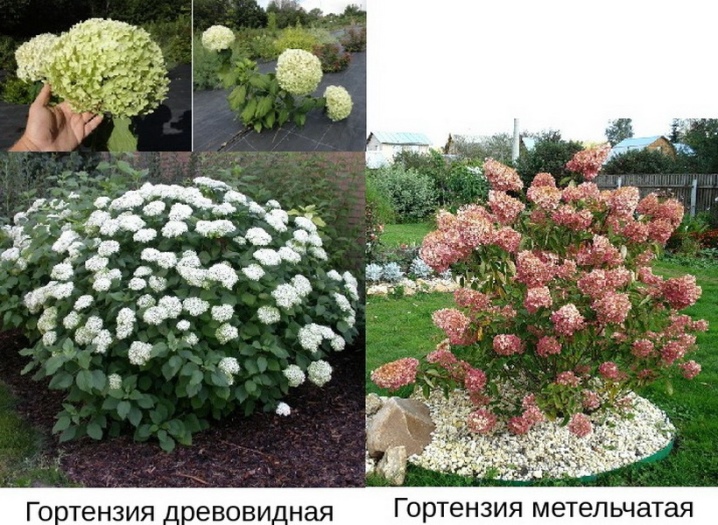
But in terms of color diversity, the species are not inferior to each other. Both shrubs will decorate virtually any natural ensemble in the garden.
Varieties
A special pleasure for the gardener is choosing varieties, trying, comparing, making discoveries and being an experimenter of some kind. And there really is plenty to choose from.
- Diamant Rouge - low grade with lush red-pink flowers. The color of the flowers changes from a faded green to red. The shrub grows up to 120 cm in height, blooms profusely and for a long time.

- Summer Snow - a low-growing variety with very dense inflorescences, they remain white almost until the end of flowering. The height of an adult plant is 80 cm. Created in one of the most famous Dutch nurseries Alex Schoemaker.

- "Dentel de Gorron" - has a cone-shaped inflorescence, the color varies from snow-white to dark pink variations. The leaves of the shrub are also bright, oblong, pointed. This white-colored variety is considered one of the most popular among gardeners.
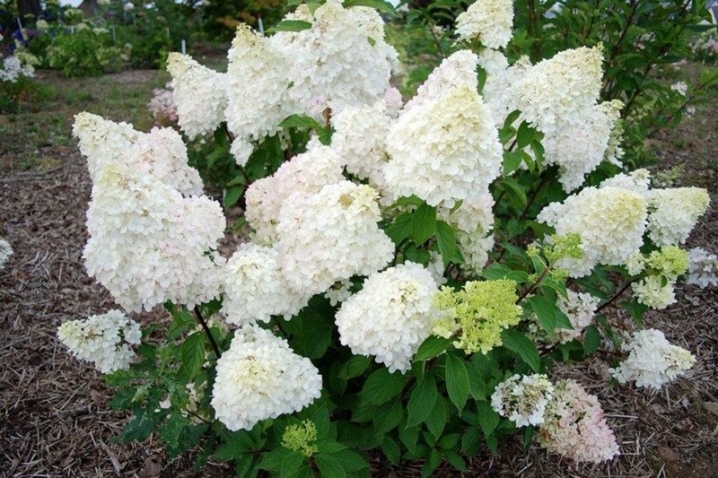
- "Unique" - the dark leaves contrast with the white flowers, which have a pale pink cast. It is also a fairly popular variety, characterized by unpretentiousness and ease of care.

- "Pearl of the Festival" - the bush grows up to 1.5 meters, has a compact rounded crown. It is distinguished by its moderate vigor, early flowering (mid-June). The flowers will initially be creamy and then white, bordered with a greenish-pink gradient.
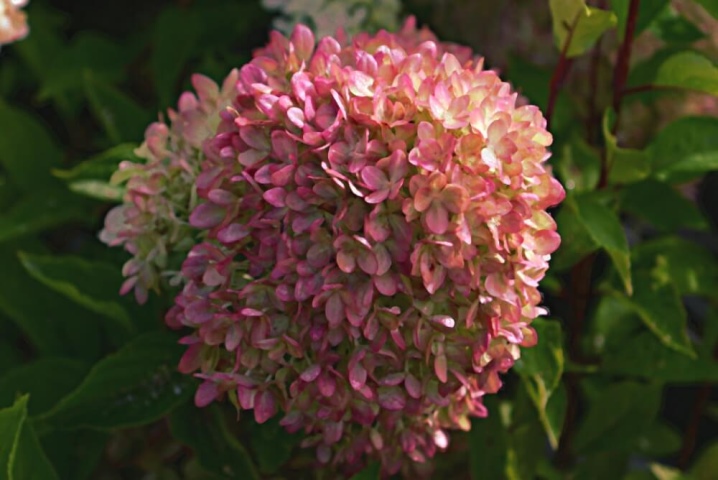
- Daruma - the variety is distinguished by a vertical fan-shaped shape, small and delicate inflorescences, a height of no more than one and a half meters. At the beginning of flowering, the flowers are soft cream, then the color turns into a confident pink.
- "Confetti" - a variety with white and light pink flowers, pleases with flowering from July to September, grows up to one and a half meters.
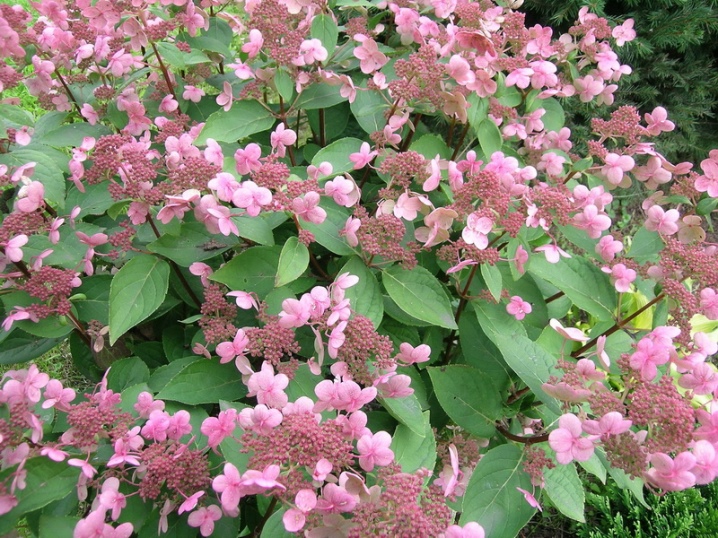
- "Selection" - a tall and powerful bush, the height of the shoot can even reach 3 m. The inflorescences are large, broadly conical. The plant begins to bloom in July, continues to bloom until mid-autumn.
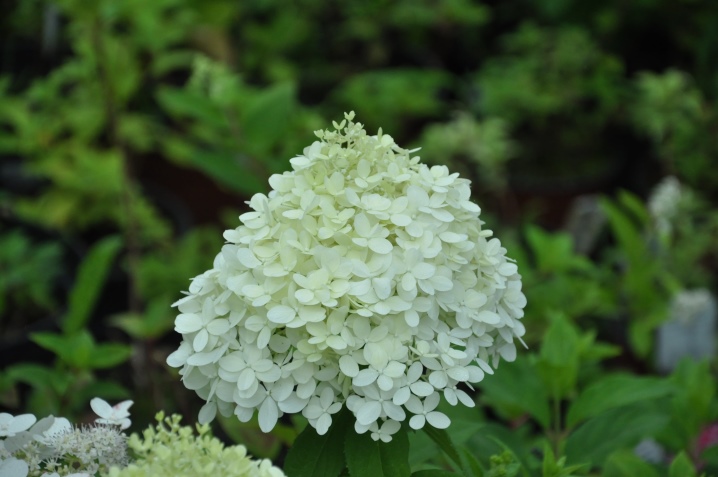
- Magic Starlight - a shrub with a compact rounded crown shape, the young shoots of which are red-brown in color. Flowering lasts from June to September.
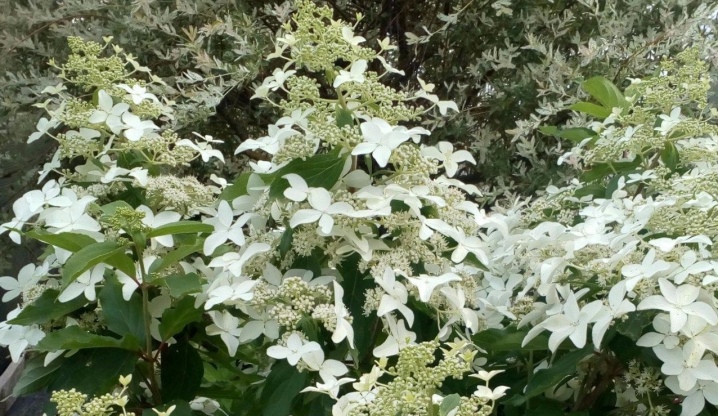
- Prim White - white hydrangea with a graceful inflorescence shape, blooms in June, earlier than all other panicle hydrangeas. Perfect for creating mixed plantings with other perennials.
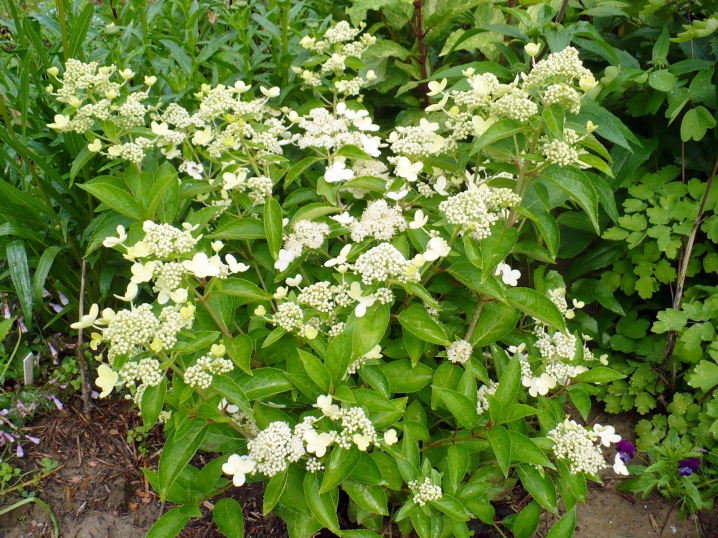
- Skyfall - the small height of the shrub gets along with rather large panicles. The inflorescences are really very large and conical. The bush is compact, the color is gaining quickly.

- "Big Ben" - the bush can grow up to 2.5 m, spreading in shape, symmetrical, its inflorescences are fragrant, conical. The variety is distinguished by high winter hardiness.

- Strawberry Blossom - a variety with white flowers that turn pink towards the end of the season. A branched bush with very strong branches, blooms already in the year of planting and blooms until October.
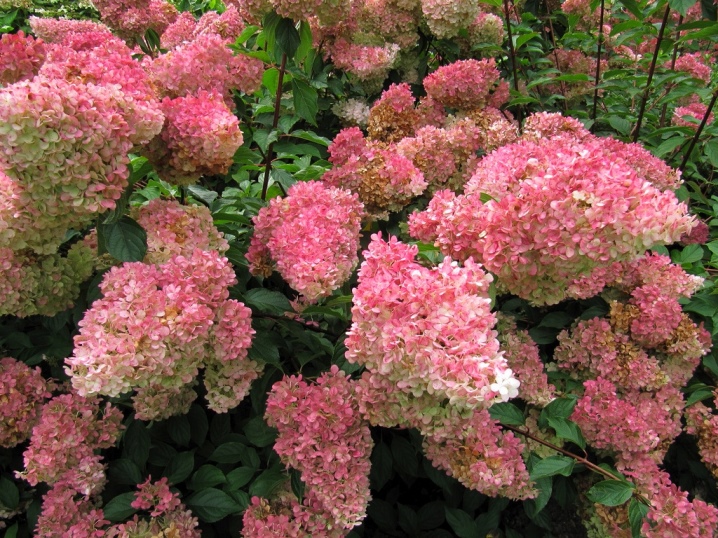
The list goes on, there are a lot of varieties. Some people mistakenly classify them as paniculata - for example, the Anabel variety refers to tree hydrangeas.
Landing
Carefully consider the choice of planting material. If you decide to buy cuttings of panicle hydrangea, pay attention to the age of the seedling - 3-4-year-old bushes will take root well. A high-quality seedling will not have chips, breaks and scratches. The roots should also be light and whole. When to plant a plant in open ground, you choose yourself: you can do it both in spring and autumn. Spring planting is, of course, preferable. During the summer period, the shrub is easier to adapt to new conditions.
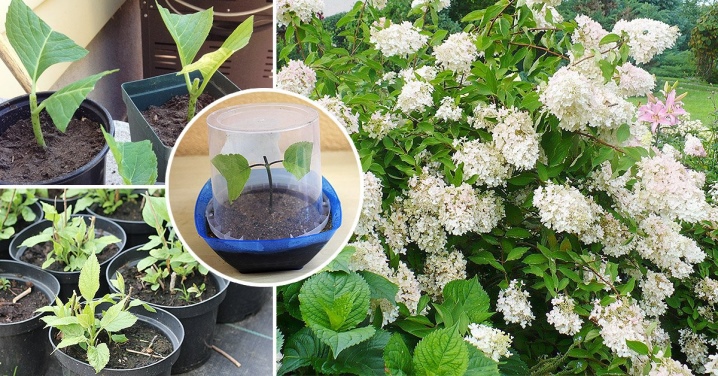
Light partial shade will be an ideal planting site for a culture. Since it is extremely susceptible to drafts, find a place protected from the wind for the plant. The composition of the soil for growing also matters: a slightly acidic soil without alkali is suitable for it.
Basic rules for planting hydrangeas from a pot.
- Planting pits usually have dimensions 50 by 50, 40-45 cm deep. If you have chosen a variety that can grow up to 2.5 m, you need to plant shrubs from each other at the same distance - 2.5 m.
- Pour 3 buckets of water into the dug hole and wait a day (it is necessary for the soil to be thoroughly saturated).
- Fill the pit with a nutrient mixture of sand, peat, and humus. Apply fertilizer - superphosphate (65 g), potassium sulfate (25 g), urea (25 g).
- Place the seedling in a fertilized hole. If necessary, gently straighten the roots, dig in with soil.
- Water the bush liberally. When the earth subsides, the space around it can be mulched. In the role of mulch, you can use coniferous needles, tree bark, the same sawdust, and more.
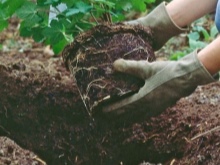

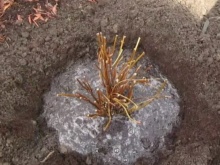
Care rules
The cultivation process itself cannot be called difficult, because the panicle hydrangea is really unpretentious. But the basic conditions must be met - these are watering, pruning, as well as fertilization and loosening.
- Watering. On dry and hot days, water the bush twice a week, in rainy weather - less often. Ice water is not used, the optimum temperature of the liquid for irrigation is 25 degrees. You can also add a hydrogel when planting in the ground, it will help protect it from drying out.
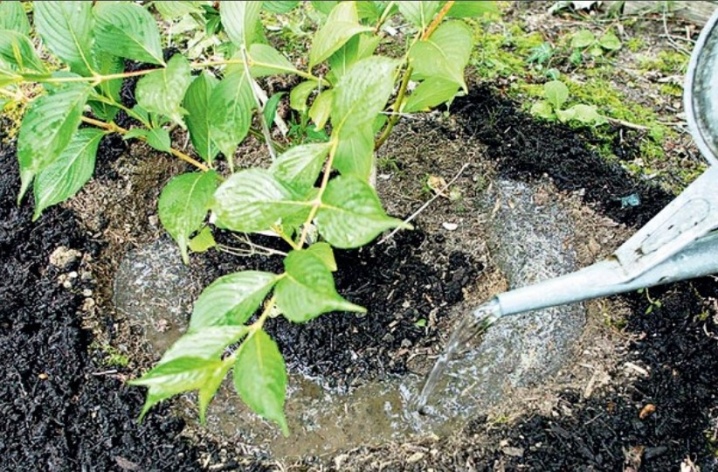
- Loosening, mulching. Loosening is a necessary procedure that allows oxygen to penetrate to the roots. It is not worth loosening the soil very deeply. Mulching, on the other hand, allows you to retain moisture, and reduce the frequency of loosening too.
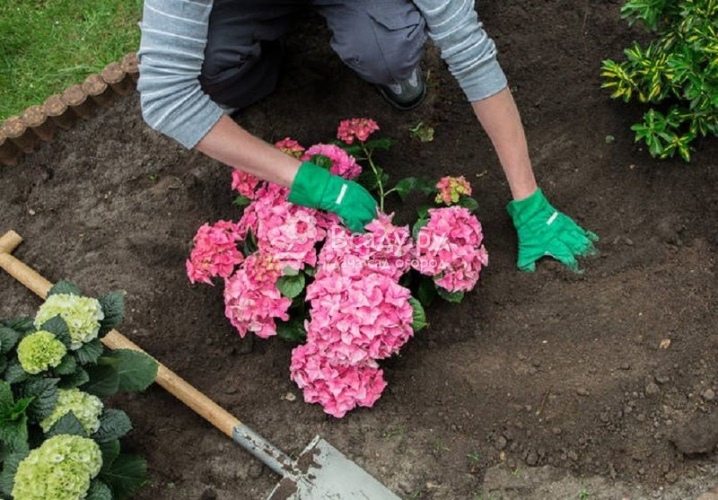
- Fertilizer. If you want to grow a really lush flowering shrub, the plant needs to be fertilized. The first feeding takes place in the spring, at the beginning of sap flow - bird droppings or mullein are suitable for this purpose. The second top dressing falls in the middle of spring and the budding period - urea, water, potassium sulfate, superphosphate are added. In the middle of summer, the plant can
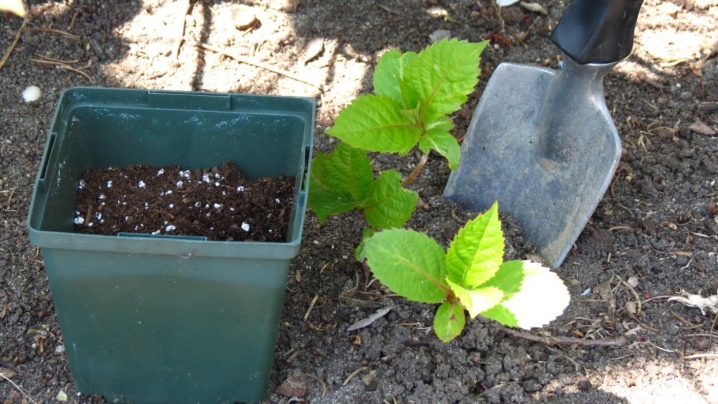
- Feed with manure, and in October you need to use a special feeding for hydrangeas (there should be no nitrogen in the composition). You may need to acidify the soil before planting.
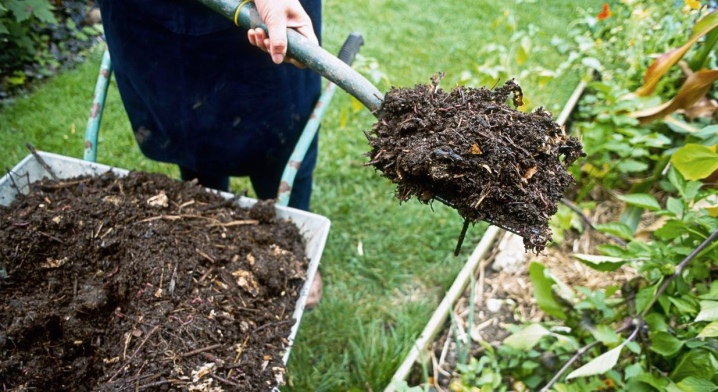
- Pruning. It is better to cut the bush in the spring, when the buds have already formed in the plant, but they have not yet blossomed. Shoots left over from last year are removed by a third. Weak and dry branches are cut off entirely.
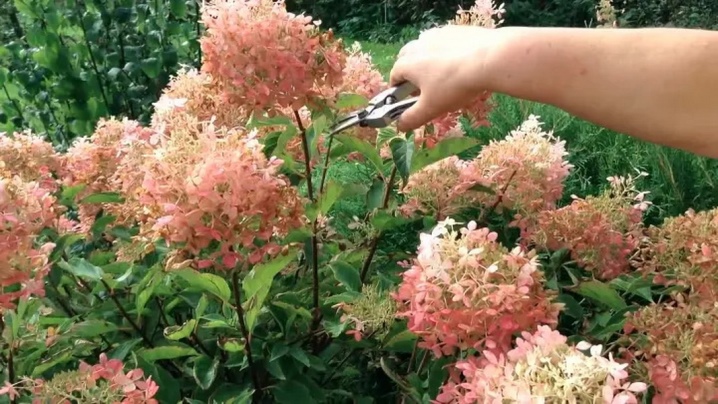
- Shelter for the winter. You can tie twigs in the fall and just bend them to the ground. You can, for example, put straw on top, close it with spruce branches. The plant can only be opened in spring, when frost is no longer threatened. And although panicle hydrangea is a winter-hardy shrub, you can save it from this stress.
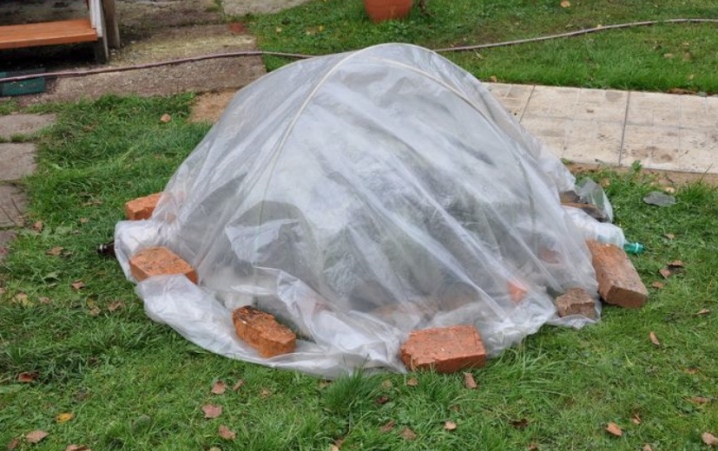
Transfer
If the place where the bush grows turned out to be unsuitable for the plant, or there was another reason for the transplant, make it "move" according to all the rules.
- Choose spring for transplanting, the best time is the beginning of sap flow. In autumn, it is undesirable to do this, because the plant will have very little time to adapt to new conditions.
- Form a new pit according to the same principle as before a regular planting. Sprinkle the plant with earth, organize abundant watering.
- Do not forget to feed the shrub after a month.
- Try to shade the plant for the first 20-25 days after transplanting. If the days are hot, you need to water the shrub 2-3 times a week.
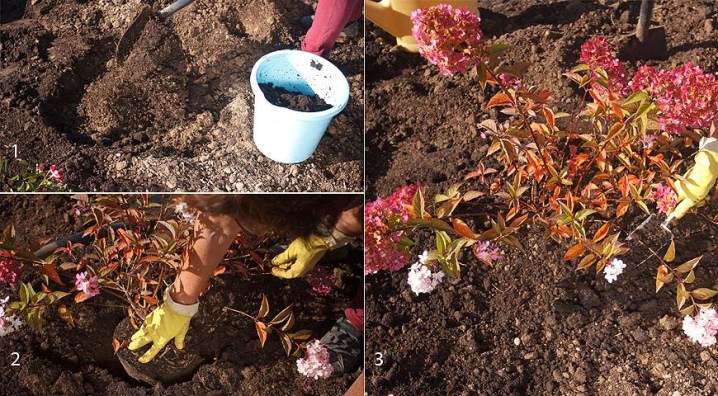
Reproduction
Gardeners use several methods of plant propagation. The simplest of them is reproduction by layering. In spring, the gardener bends a low-growing shoot to the ground, fixes it and covers it with soil. Throughout the growing season, the layering must be looked after in the same way as the main bush. And for the winter it should also be covered. The next spring, the shoot must be separated from the mother part, and then transplanted to the chosen place.

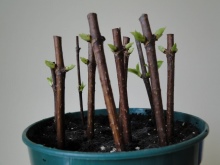
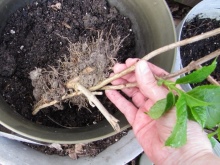
When grafting in spring, you need to cut off twigs with 5 buds, then place them in "Kornevin" for 2 days. Then the cuttings are placed on temporary soil, shaded. In autumn, they also need to be covered in order to protect them from frost. When the seedlings are 4-5 years old, they can be transplanted to a permanent place. When propagating by dividing the bush, remove the root from the ground, carefully divide it into several parts. Plant the resulting cuttings in the previously dug and fertilized pits. Remember that the first 3 weeks the seedlings need to be protected from ultraviolet rays.
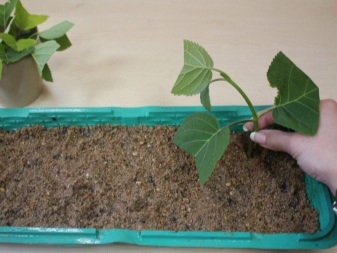
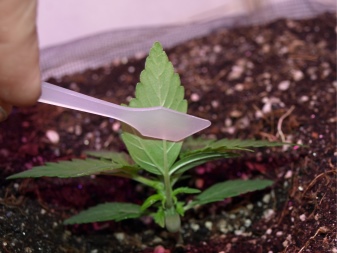
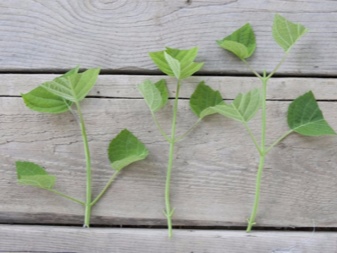
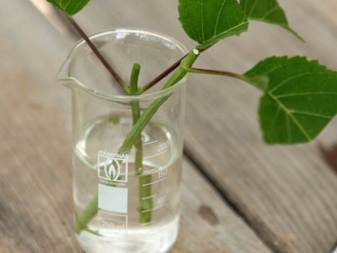
If you grow plants on a trunk, then you know that they are winter hardy. But during reproduction, this quality is at risk, therefore, be sure to cover the shrub for the winter.
Diseases and pests
The first range of possible diseases of paniculate hydrangea is ailments caused by poor growing conditions. So, the plant can be weakened by sunburn, deficiency or excess of water, insufficient mineral balance of the soil.
- Chlorosis - may occur due to a lack of iron in the soil or excess lime. The symptomatology is as follows: yellow and dried leaves with remaining green veins. In this case, the soil must be softened, acidified with aluminum sulfate or peat. You can also soften the water for irrigation with ash. It may be necessary to reduce the intensity of the mineral feeding.
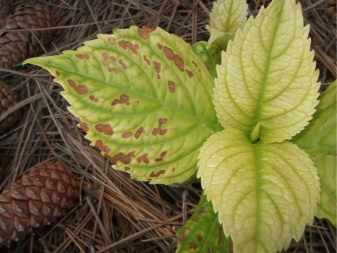
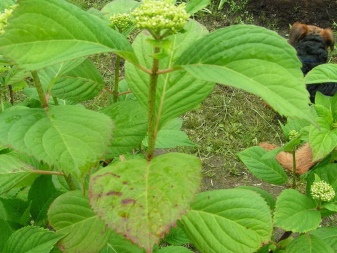
- Leaf burns - look like translucent whitish spots. The affected areas become thinner and may dry out. Treatment consists of shading the plant.But the panicle hydrangea is not as vulnerable to burns as the tree hydrangea.
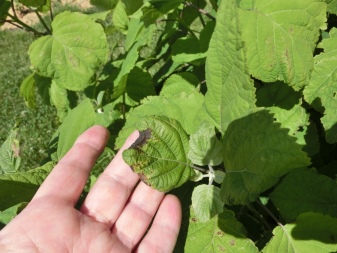

- White rot - the fungus infects the roots, the disease spreads from other plants or through plant debris. It is rarely found outdoors. But if you see darkened shoots, rotting stems near the ground, white "cotton" bloom on the leaves, then the hydrangea is affected by white rot. There is little cure for this disease, and it threatens to infect other plants in the area.

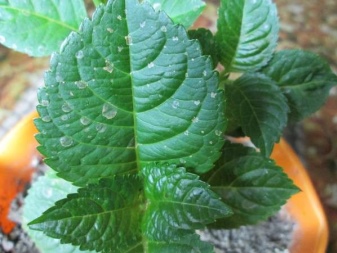
- Gray rot - affects leaves and young plant tissues. The disease usually occurs from waterlogging, as well as from overcrowding of shrubs. A soft gray bloom on the leaves suggests that dead areas need to be urgently removed and burned. After their removal, the plants should be treated with potassium permanganate. But if the disease has gone far, the plant will have to be removed in order to avoid mass contamination of crops on the site.
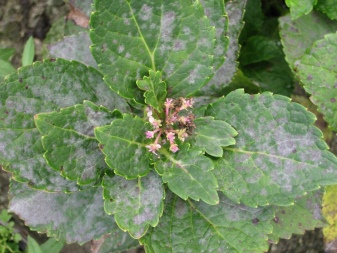

- Downy mildew - oily specks appear on the leaves. The affected areas should be removed as soon as possible. A plant that has undergone the removal of damaged areas needs to be sprayed with a 1% solution of Bordeaux mixture.
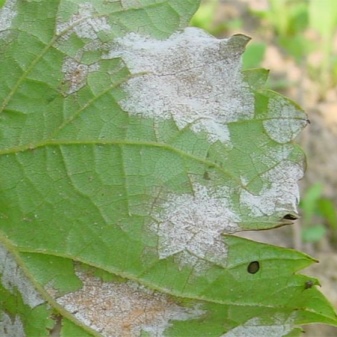
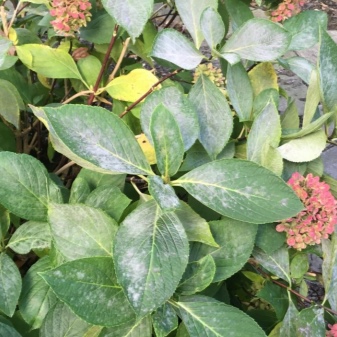
- Powdery mildew is real - the leaves turn yellow, become covered with specks. The plaque on the back can be gray-purple. Problematic areas need to be removed and burned, the plant must be treated with fungicides. Remember that such processing the next year after the first is impossible, you need to take a year break between them.
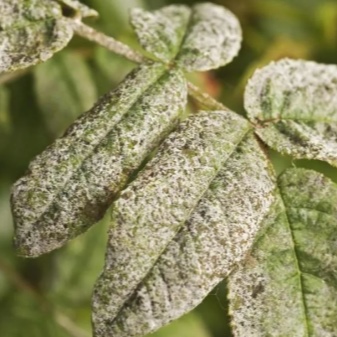
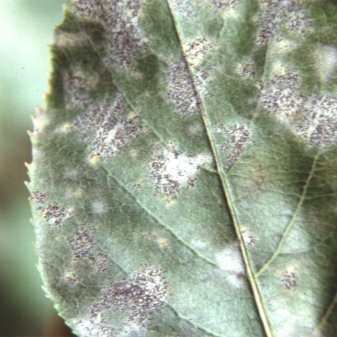
- Septoriasis - It is expressed by the defeat of the leaves with light spots in the center and brown spots along the edges. If the plant is severely affected, spots may even appear on the stems. The affected areas must be removed, the sections must be treated with potassium permanganate. Septoria from hydrangea can "spread" to apple, raspberry, eggplant, and some flowers.
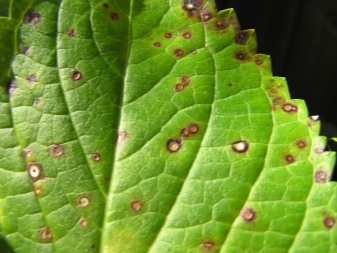

- Rust - appears from excess water and nitrogenous fertilizers. The symptomatology is expressed as small yellow specks, which then transform into brown growths. And rusty dust can fall from these growths - these are the spores of the fungus, which are easily carried by the wind. Dried leaves must be removed, then the plant will have to be treated with copper chloride.
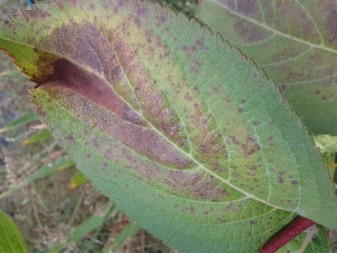
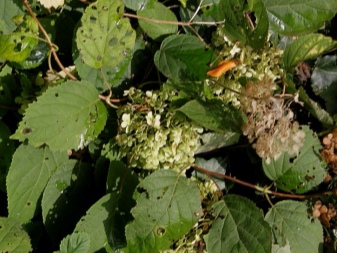
Pests threaten hydrangeas no less than fungi. One such attacking parasite is the leaf aphid. It settles in colonies on the bush, which is why its leaves begin to turn yellow and dry. If the aphid colony is small, then the bush can simply be doused with water from a hose. And if the aphid has thoroughly captured the plant, you will have to use insecticides. If you plant marigolds nearby, these flowers will attract ladybirds, which are considered the main enemy of aphids. If a thin web has appeared on the leaves of the hydrangea, a spider mite may have captured the plant. Leaves affected by this pest can curl and curl. If the lesion is not severe, it is enough to apply a soapy solution or any mineral oil to the leaves. But if the defeat by the pest is great, a stronger blow is needed to fight them - means "Lightning" or "Akarin".
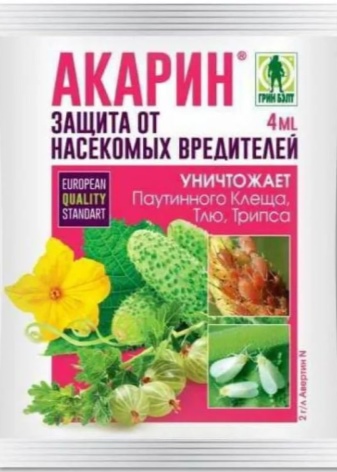
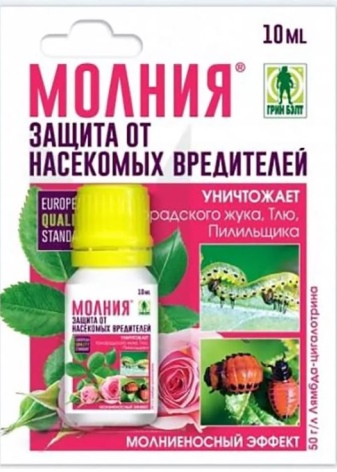
There are pests that are sometimes impossible to cope with. All hope is only for prevention, as in the case of rootworm nematode. Tilling the soil with "Fitoverm" will protect the plant from this pest. If you notice a garden slug next to the hydrangea, you need to pick it up by hand, destroy the egg clutches.
Possible problems
What to expect when growing hydrangeas, what problems are possible and how to solve them - these are the most frequent questions of the gardener. Consider ways to solve them
- Hydrangea does not bloom. There can be many reasons: for example, beginners manage to cut off all the shoots for the winter. But the buds are formed in the fall, so pruning will lead to a complete lack of flowers. The problem may lie in the freezing of the buds, and in the bright sun, and in the absence of regular watering.
- Only gives foliage. There can also be several reasons. If there are few flowers and mainly one foliage, the plant could freeze.It is possible that the soil in the place of cultivation of the crop is depleted. Finally, the hydrangea got sick. You can make a warm humus pillow under the roots for the winter, so you will protect the plant from freezing.
- Does not change color. Self-color change is another quality of hydrangea that gardeners love it for. Remember that only pink or blue plants lend themselves to repainting, the white variety will not change in any way. To get blue shades, you need acidic soil, a sufficient amount of aluminum salts, a minimum of phosphorus. For pink shades, it is correct to maintain a neutral or alkaline soil, inaccessibility of aluminum salts.

Interestingly, even on one hydrangea bush, you can get multi-colored inflorescences. To do this, different sides of the bush need to be fertilized and watered with different substances.
Use in landscape design
When planting hydrangeas, focus on the general style of the garden. For example, paniculate shrubs will look great on a site decorated in Russian style. On the shore of a reservoir (and an artificial one too), these plants will look very attractive. And to create a shrub hedge scheme, you can combine several varieties. Shrubs are traditionally shaped by pruning.
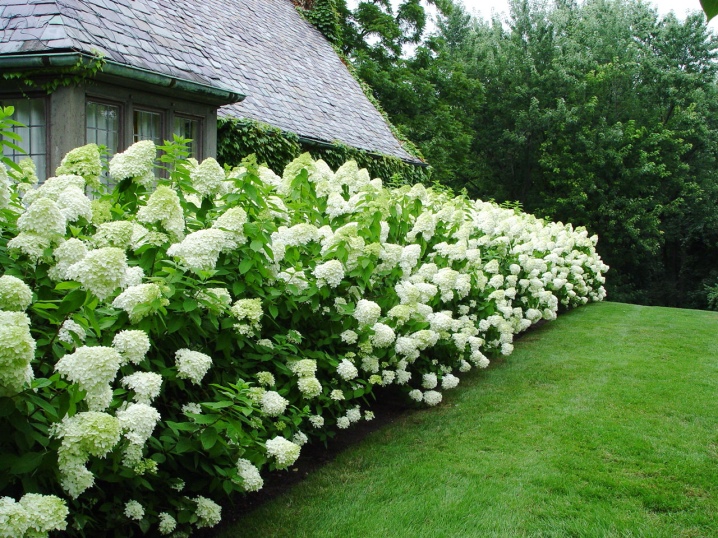
A photo selection of the best options for panicle hydrangea in landscape gardening design.
- Decorative lilac trees near the fence always look tender, soft, and it is simply impossible to pass by without admiring the lush plant.
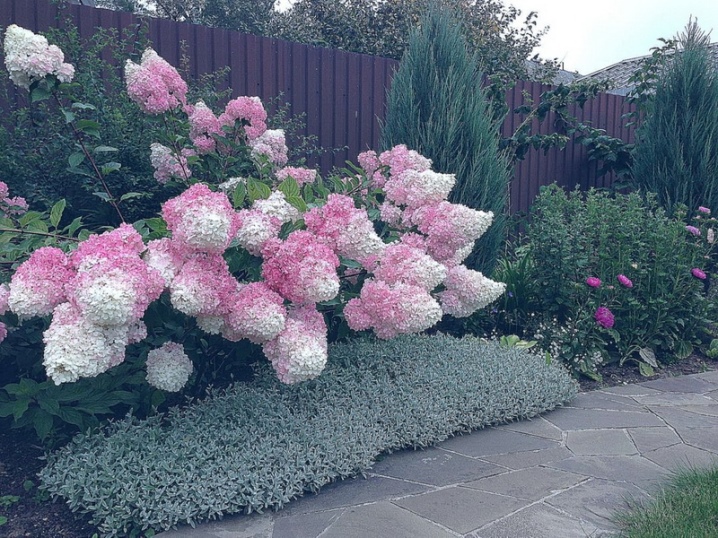
- The bush by the bench is a classic solution and almost always a win-win.
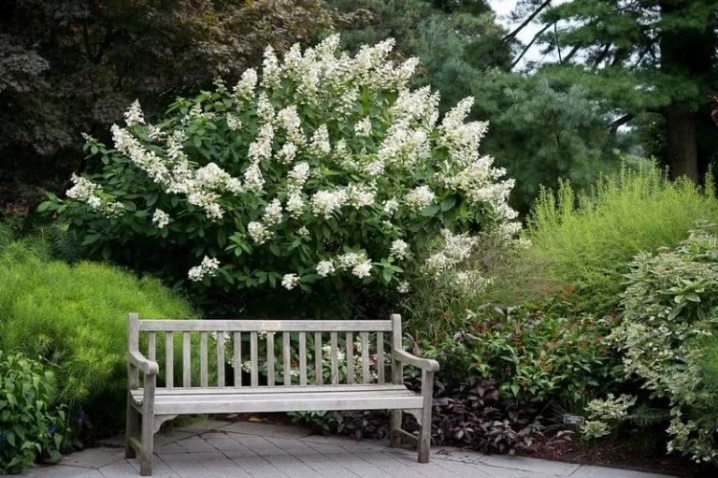
- White lush bushes along the reservoir are a worthy framing of the recreation area.

- Next to decorative stones, the shrub will also look convincing and graceful.
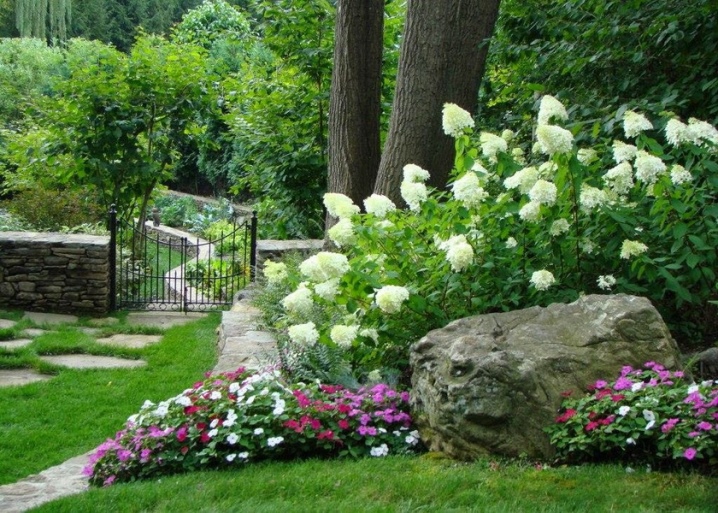
- Hydrangea and fountains can surround, only do not select too high varieties for such a purpose.
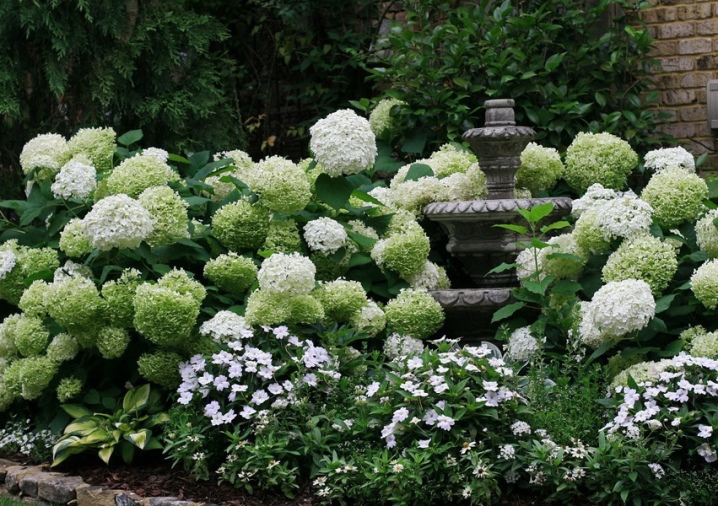
- The layering is perfectly sustained, in which the plants help each other to be visually brighter and more expressive.
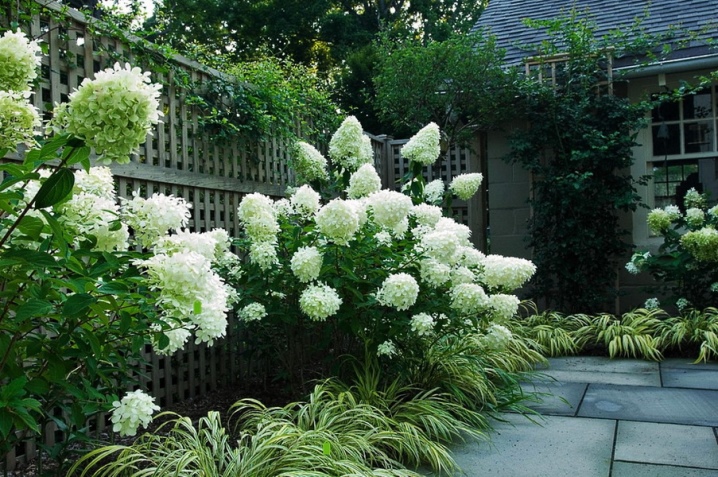
- Surrounding the house with a fluffy white pillow is an interesting solution, and the bright flowers planted nearby do not interfere with the idea at all.
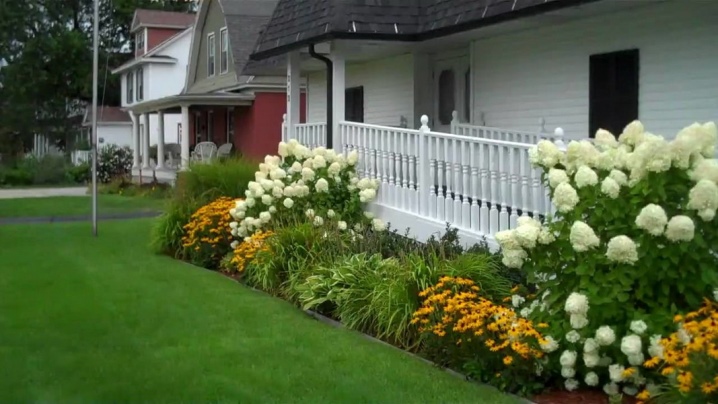
- White bushes near a white fence are very beautiful, delicate, subtle. The place will become a favorite area for photo shoots.
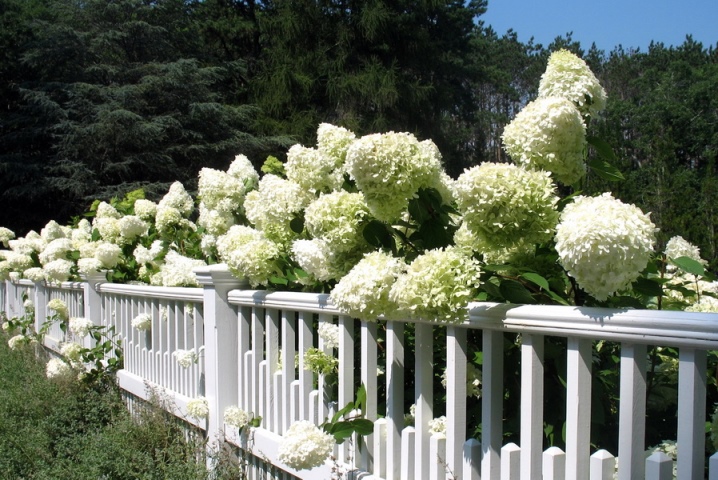
- For lovers of blue, this photo is just a delight for the eyes. Indeed, a pretty sight, the main thing here is not to overdo it with color when forming the landscape.
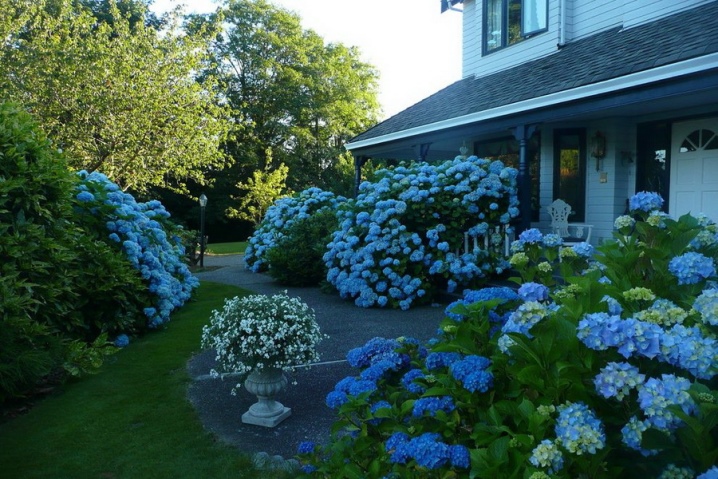
- Hydrangea along the embankment path looks cute and a little sentimental. You can play with the height of the bushes.
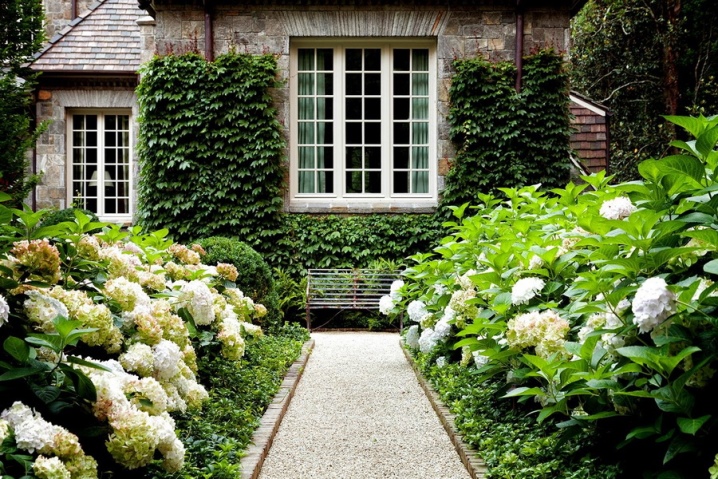
If you are a beginner gardener, then your first experimental shrub can be a docile and very beautiful panicle hydrangea.
For information on how to properly care for panicle hydrangea, see the next video.





























































The comment was sent successfully.